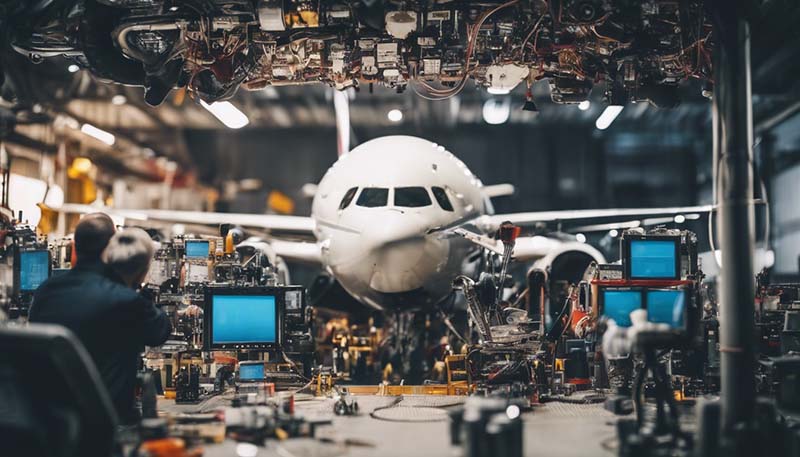Air travel has become an integral part of our daily lives, providing us with the ability to travel vast distances in a short amount of time. With the increasing demand for air travel, it is essential to ensure the safety of passengers, crew, and the general public. One of the critical components in achieving this goal is aircraft maintenance. This article will discuss the role of aircraft maintenance in ensuring air safety, the various aspects of maintenance, and the importance of a well-structured maintenance program.
Introduction to Aircraft Maintenance
Aircraft maintenance is the process of preserving and restoring an aircraft's optimal performance throughout its life cycle. It involves a series of tasks and inspections performed by trained professionals to ensure that the aircraft remains airworthy and safe for operation. These tasks include visual inspections, functional checks, component replacements, and structural repairs, among others. The primary objective of aircraft maintenance is to prevent accidents and ensure the safety of passengers, crew, and ground personnel.
Advertisement
The Importance of Aircraft Maintenance
The importance of aircraft maintenance cannot be overstated, as it directly contributes to the safety and reliability of air travel. Properly maintained aircraft are less likely to experience in-flight incidents, which can lead to significant consequences, including fatalities, injuries, and property damage. Moreover, a well-maintained aircraft is more fuel-efficient, which not only reduces operational costs but also minimizes the environmental impact of air travel.
Aircraft Maintenance Programs
Aircraft maintenance programs are designed to ensure that all aspects of an aircraft's maintenance are addressed systematically and effectively. These programs typically include routine inspections, scheduled maintenance, and unscheduled repairs. The following sections will provide a detailed overview of each aspect of aircraft maintenance programs.
Routine Inspections
Routine inspections, also known as pre-flight and post-flight inspections, are conducted before and after each flight to ensure that the aircraft is in proper working order. These inspections involve a thorough visual examination of the aircraft's exterior and interior, including the wings, engines, landing gear, and cabin. The purpose of routine inspections is to identify any discrepancies, such as leaks, cracks, or other signs of wear and tear, that may affect the aircraft's safety and performance.
Scheduled Maintenance
Scheduled maintenance, or periodic maintenance, is performed at regular intervals based on the aircraft's flight hours, calendar days, or cycles (takeoffs and landings). This type of maintenance includes more in-depth inspections, functional tests, and component replacements, as specified by the aircraft manufacturer and regulatory authorities. Scheduled maintenance helps to prevent unexpected failures and ensures that the aircraft remains airworthy and compliant with safety regulations.
Unscheduled Repairs
Unscheduled repairs, or non-routine maintenance, are required when an aircraft experiences a malfunction or failure that cannot be deferred until the next scheduled maintenance interval. These repairs may include emergency landings, in-flight repairs, or on-ground troubleshooting. Unscheduled repairs are crucial in maintaining the aircraft's safety and operational integrity, as they address issues that could potentially lead to accidents or incidents.

Training and Certification
Ensuring that aircraft maintenance is performed by qualified and trained professionals is crucial for maintaining air safety. Aircraft maintenance technicians and engineers must undergo extensive training and obtain certifications from regulatory authorities, such as the Federal Aviation Administration (FAA) in the United States or the European Union Aviation Safety Agency (EASA) in Europe. These certifications ensure that maintenance personnel possess the necessary knowledge, skills, and expertise to perform their duties effectively and safely.
Technological Advancements in Aircraft Maintenance
The aircraft maintenance industry has witnessed significant technological advancements in recent years, which have improved the efficiency and effectiveness of maintenance processes. Some of these advancements include:
- Condition-based maintenance (CBM): CBM utilizes sensors and monitoring systems to track the health and performance of aircraft components in real-time. This allows maintenance personnel to identify and address issues before they become critical, reducing the risk of in-flight incidents.
- Predictive maintenance: Predictive maintenance leverages data analytics and machine learning algorithms to predict potential failures and schedule maintenance accordingly. This proactive approach minimizes downtime and ensures that aircraft are always in optimal condition for operation.
- Augmented reality (AR) and virtual reality (VR): AR and VR technologies are being used to enhance maintenance training and procedures. These technologies provide immersive and interactive experiences, allowing technicians to visualize complex systems and perform maintenance tasks more efficiently and accurately.
Conclusion
Aircraft maintenance plays a vital role in ensuring air safety and the overall reliability of air travel. By implementing robust maintenance programs, investing in training and certification, and embracing technological advancements, the aviation industry can continue to provide safe and efficient air transportation for passengers and crew worldwide.